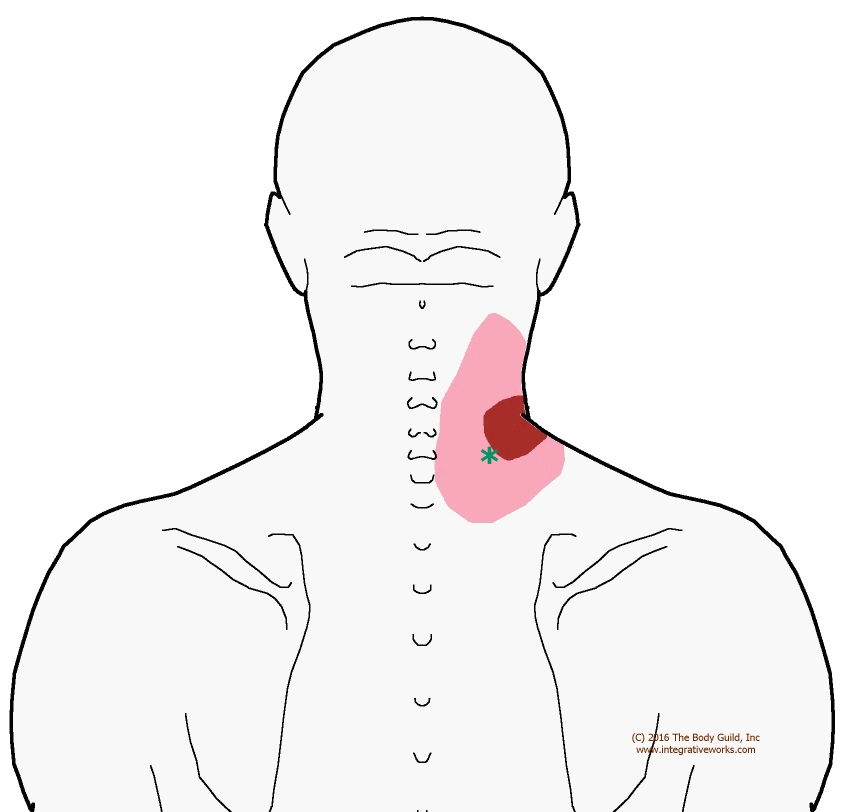Pain at the Base of the Neck When Turning
Table of Contents
- How People Describe This Pain Pattern
- How You Activate and Intensify This Pain Pattern
- Self-Care – Getting Relief on Your Own
- Musculoskeletal Anatomy Behind Your Pain
- Therapy Notes for Massage and Bodywork
How People Describe This Pain Pattern


People turn their heads and complain of stiffness and pain that focuses on a spot on one side of the base of their neck. When I ask for more details, they often turn their head slowly until they say, “There. It hurts right there.” When I ask them to touch where it hurts, they lay their hand on the base of their neck and as they turn. Then, they often say it interferes with their driving while trying to change lanes.
As with other stiff neck problems, like the pain along the side of the neck, they tend to turn their eyes and shoulders instead of turning their head when looking to the side.
They don’t usually complain about pain while breathing. However, when I ask them to take a deep breath, the often have some soreness at the base of the neck, or a little below.
When I ask about their vision, they often look surprised. This trigger point often leaves them with some problems with blurred vision. As well, this muscle tends to increase anxiety and exacerbate sensory defensiveness.
How You Activate and Intensify This Pain Pattern
Forward Jerk
This pain at the base of the neck while turning can be stressed by things that suddenly or chronically pull the head forward. Those activities include an unusual sports weekend that involves looking up, like rock climbing. They may have been lifting things while looking up to put them on a shelf.
Laptop Ergonomics
One client complained of aggravating it while awkwardly sitting and working on their laptop, which was on, well, their lap. They folded forward for a long time, craning their neck down while typing. Breathing like this creates a problem with one of the upper ribs, perpetuating this trigger point. Trying to breathe while pulling the head forward and bending the torso stresses this muscle.
That Phone
When I ask if they have been texting or looking straight down at something, they will sometimes realize that they have a new smartphone or use their phone more than usual. This condition worsens when the hips slide forward in the chair, and the neck muscles pull the shoulders up while breathing.
Commonly, they complain about how they “slept funny.” Likely, this trigger point activates when the muscle gets cold while they “sleep funny.”
The Musculoskeletal Anatomy Behind Your Pain
Musculoskeletal Anatomy
This post on anatomy contains standard information about the origin, insertion, function, and innervation of muscles. Additionally, it includes information on functional considerations and anomalies.
Find Related Posts
Anatomy posts have a grid of all related posts. This includes posts on pain patterns, self-care, therapy notes, NMT protocols, cranial techniques, and cases.
Getting Relief on Your Own
Clinically Proven
Self-Care Strategies
Self-Care Posts have common sections to make them easy to follow and understand:
- Activities to Avoid or Change
- Strategies for Quick Relief
- Stretches and Exercise for Longer-Lasting Relief
- Yoga Corner
Therapy Notes for Massage and Bodywork
Better Bodywork
Through Shared Expertise
Therapy Notes provide details for cranial, spinal, and local joint work. These notes also link to a traditional neuromuscular protocol.
By treating integrative components first, direct work on the muscle becomes less intense while providing longer-lasting relief.
Support Integrative Works to
stay independent
and produce great content.
You can subscribe to our community on Patreon. You will get links to free content and access to exclusive content not seen on this site. In addition, we will be posting anatomy illustrations, treatment notes, and sections from our manuals not found on this site. Thank you so much for being so supportive.
Cranio Cradle Cup
This mug has classic, colorful illustrations of the craniosacral system and vault hold #3. It makes a great gift and conversation piece.
Tony Preston has a practice in Atlanta, Georgia, where he sees clients. He has written materials and instructed classes since the mid-90s. This includes anatomy, trigger points, cranial, and neuromuscular.
Question? Comment? Typo?
integrativeworks@gmail.com
Follow us on Instagram
*This site is undergoing significant changes. We are reformatting and expanding the posts to make them easier to read. The result will also be more accessible and include more patterns with better self-care. Meanwhile, there may be formatting, content presentation, and readability inconsistencies. Until we get older posts updated, please excuse our mess.